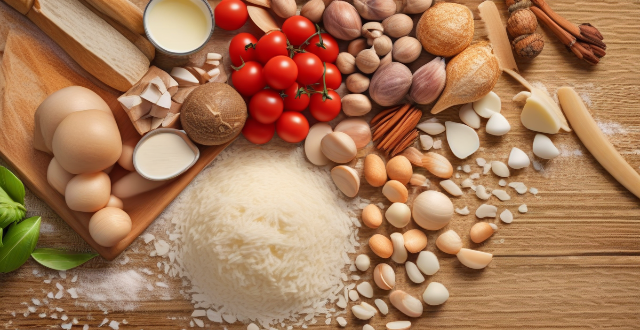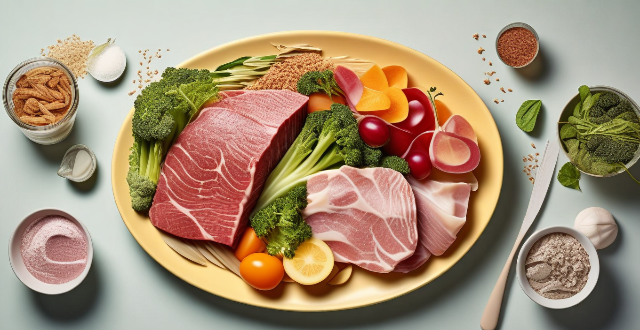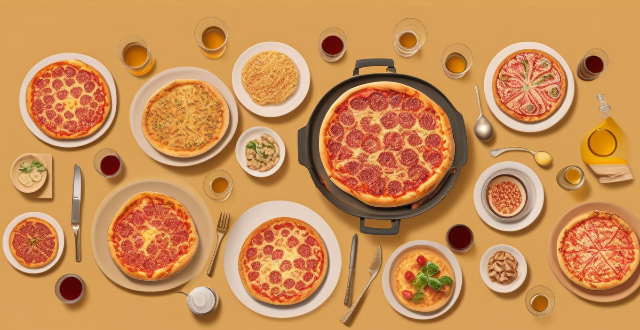Japanese Cuisine

What kind of ingredients are commonly used in Japanese cuisine ?
Japanese cuisine is known for its unique flavors, fresh ingredients, and beautiful presentation. The most commonly used ingredients in Japanese cooking include white rice, brown rice, sweet rice, tuna, salmon, squid, shellfish, chicken, beef, pork, cabbage, eggplant, green onions, mushrooms, soy sauce, miso, udon noodles, soba noodles, ramen noodles, rice vinegar, sesame oil, nori, wasabi, and pickled ginger. These ingredients combine to create the diverse and delicious flavors that make Japanese cuisine so beloved around the world.

How does Chinese cuisine differ from other Asian cuisines ?
Chinese cuisine is one of the most diverse and influential cuisines in the world, with a history that spans thousands of years. While there are many similarities between Chinese cuisine and other Asian cuisines, there are also several key differences that set it apart. These differences include the use of ingredients, cooking techniques, flavor profiles, and regional variations within each cuisine. Chinese cuisine often uses a wider variety of ingredients than other Asian cuisines, including both meat and vegetables. Additionally, Chinese cuisine often incorporates more spices and herbs into its dishes than other Asian cuisines. Another difference is the cooking techniques used. Chinese cuisine often involves stir-frying or steaming foods, while other Asian cuisines may rely more heavily on grilling or baking. Chinese cuisine also tends to use woks for cooking, which allows for high heat and quick cooking times. In terms of flavor profiles, Chinese cuisine has a distinct flavor profile that sets it apart from other Asian cuisines. Chinese cuisine often features bold flavors such as garlic, ginger, soy sauce, and chili peppers. In contrast, Japanese cuisine may have a lighter, more delicate flavor profile that emphasizes umami (savory) flavors. Thai cuisine, on the other hand, may be spicier and more aromatic than Chinese cuisine. Finally, another difference between Chinese cuisine and other Asian cuisines is the regional variations within each cuisine. China has a vast geographic area with many different regions, each with its own unique culinary traditions. Similarly, Japanese cuisine can vary greatly depending on whether it comes from the northern or southern regions of Japan.

Can you explain the concept of umami in Japanese cooking ?
Umami is one of the five basic tastes, along with sweet, sour, salty, and bitter. It is often described as a savory or meaty taste, and is commonly found in foods such as mushrooms, soy sauce, and aged cheeses. In Japanese cooking, umami is considered an essential flavor profile that adds depth and complexity to dishes. The science of umami is caused by the presence of glutamate, a type of amino acid, in food. When we eat foods that contain glutamate, it stimulates our taste buds and sends signals to our brain that register as a distinct taste. This taste is often associated with protein-rich foods like meat, fish, and vegetables. In Japanese cuisine, umami is used to enhance the flavors of dishes and create a more complex taste profile. Some common ingredients that are high in umami include miso (fermented soybean paste), dashi (Japanese broth made from dried fish and seaweed), soy sauce, dried shiitake mushrooms, and kombu (a type of seaweed). Umami is used in a variety of ways in Japanese cooking. For example, miso soup is made by mixing miso paste with dashi broth to create a savory soup that is often served as part of a traditional Japanese breakfast. Sushi combines vinegared rice, fresh fish, and soy sauce to create a perfect balance of flavors that includes umami. Ramen noodles use a broth made with chicken or pork bones, which are rich in umami. Teppanyaki involves grilling meat and vegetables on a hot plate, which helps to release their natural umami flavors. In conclusion, umami is an important flavor profile in Japanese cooking that adds depth and complexity to dishes. By using ingredients that are high in glutamate, chefs can create dishes that are both delicious and satisfying.

In what ways does cultural fusion influence food and cuisine around the globe ?
Cultural fusion significantly impacts global cuisine by introducing diverse ingredients, techniques, and fusion cuisines. It encourages culinary innovation and creativity while also promoting the globalization of food cultures. Additionally, cultural fusion affects eating habits and dietary restrictions worldwide.

What are some popular Japanese dishes ?
Japanese cuisine is known for its exquisite flavors, meticulous preparation, and beautiful presentation. Some popular dishes include sushi, ramen, tempura, udon, and okonomiyaki. Sushi comes in various forms such as nigiri, sashimi, and maki. Ramen is a noodle soup with different broths and toppings. Tempura is a fried dish with a light batter. Udon is thick noodles served hot or cold with various toppings. Okonomiyaki is a savory pancake with diverse ingredients. Each region in Japan has its own specialties and unique flavors to explore.

What are some healthy options for Japanese breakfast ?
Japanese breakfast offers a variety of healthy options that provide essential nutrients and flavors. Miso soup is rich in protein and probiotics, aiding digestion and immunity. Tamagoyaki offers high-quality protein in a low-calorie package. Natto is fermented soybeans with vitamins, minerals, and probiotics for gut health. Onigiri are portable rice balls filled with various ingredients for carbohydrates and protein. Grilled fish provides omega-3 fatty acids for heart and brain health. Japanese pickles are low-calorie, fiber-rich vegetables aiding digestion. Yudofu is boiled tofu high in protein and calcium, suitable for vegans or those watching their weight. Okara, the soy milk residue, is high in fiber and protein, promoting fullness and digestive health. Incorporating these dishes into your breakfast routine can offer a balanced and nutritious start to the day while enjoying Japanese flavors.

Where can I find a fine dining experience in Tokyo, Japan ?
Tokyo is famous for its diverse culinary scene, offering a wide range of fine dining experiences that cater to various tastes and preferences. Whether you're in the mood for traditional Japanese cuisine or international fare, there are plenty of options to choose from. Here are some of the top places to find a fine dining experience in Tokyo: ## Traditional Japanese Cuisine ### Kohju - **Location**: Ginza district - **Cuisine**: Kaiseki (traditional multi-course meal) - **Highlights**: Elegant atmosphere, seasonal ingredients, skilled chefs - **Price Range**: High-end ### Ishikawa - **Location**: Shibuya district - **Cuisine**: Sushi (raw fish served with vinegared rice) - **Highlights**: Fresh seafood, expert sushi craftsmanship, intimate setting - **Price Range**: Moderate to high-end ## International Cuisine ### Quintessence - **Location**: Shiodome district - **Cuisine**: French - **Highlights**: Innovative dishes, impeccable service, stunning views of Tokyo Bay - **Price Range**: High-end ### Narisawa - **Location**: Minami Aoyama district - **Cuisine**: Modernist Japanese with international influences - **Highlights**: Creative presentations, locally sourced ingredients, artistic plating - **Price Range**: High-end ## Vegetarian/Vegan Options ### Yohji - **Location**: Harajuku district - **Cuisine**: Vegan Japanese fusion - **Highlights**: Flavorful plant-based dishes, unique flavor combinations, cozy atmosphere - **Price Range**: Moderate ### Sougo - **Location**: Roppongi district - **Cuisine**: Vegan Italian - **Highlights**: Hearty pastas, authentic Italian flavors, friendly staff - **Price Range**: Moderate to high-end ## Budget-Friendly Options ### Ichiran Ramen - **Location**: Multiple locations throughout Tokyo - **Cuisine**: Ramen (noodle soup) - **Highlights**: Customizable broth and toppings, fast service, affordable prices - **Price Range**: Affordable ### Tenya - **Location**: Multiple locations throughout Tokyo - **Cuisine**: Tendon (tempura over rice) - **Highlights**: Crispy tempura, generous portions, quick meals on the go - **Price Range**: Affordable No matter your budget or dietary preferences, Tokyo offers a diverse array of fine dining experiences that will leave you satisfied and eager to return for more.

What is the difference between ramen and udon noodles ?
Ramen and udon are two popular Japanese noodle dishes with unique flavors, textures, and cultural significance. Ramen is made from wheat flour, water, salt, and kansui, resulting in elastic and chewy noodles. It is typically served in a meat-based broth flavored with soy sauce, miso, or seafood, and topped with pork, menma, scallions, nori, and a soft-boiled egg. Udon, on the other hand, is made primarily from wheat flour and water, producing thicker and smoother noodles. Its broth is usually clear and light, made from kombu and shiitake mushrooms, and often served hot or cold with simple toppings like tempura, green onions, or grated ginger. Ramen originated in China but became popular in Japan during the early 20th century, evolving into a staple of Japanese cuisine. It has numerous regional variations across Japan, such as Sapporo's miso ramen, Hakata's tonkotsu ramen, and Tokyo's soy sauce-based ramen. Ramen shops can be found everywhere in Japan, from high-end establishments to quick street food stalls, reflecting its deep integration into daily life. Udon has been part of Japanese cuisine for centuries and is traditionally associated with Sanuki (now Kagawa Prefecture), known as the "Udon Kingdom." While udon is typically served in a simple broth or chilled with a dipping sauce, there are also hot pot variations like nabe and kitsune (fox) udon. Udon is often considered comfort food in Japan and is frequently consumed during cold weather or as a quick meal due to its ease of preparation. In conclusion, ramen and udon offer distinct experiences for those who enjoy them. Ramen provides a hearty and filling meal with complex broths and diverse toppings, while udon offers a cleaner taste with simpler broths and toppings, focusing on the pure enjoyment of the noodle itself. Both have their place in Japanese cuisine and continue to captivate noodle enthusiasts around the world.

How has Indian cuisine evolved over time ?
The evolution of Indian cuisine is a result of various factors such as geography, climate, history, culture, and trade. India's diverse geography and climate have led to unique culinary traditions in each region, with coastal areas known for seafood dishes and northern plains famous for dairy products and bread. Historical influences like the Mughal era and British colonial period have also shaped Indian cuisine, introducing fusion dishes and bakeries. Trade routes and globalization have integrated foreign flavors into Indian dishes, while regional variations highlight the country's culinary diversity. Modern innovations include fusion dishes and healthier versions of traditional recipes. Overall, Indian cuisine reflects the nation's rich cultural diversity and adaptability to changing trends.

Can you recommend a good Japanese restaurant in my area ?
The text provides recommendations for finding a good Japanese restaurant in one's area. It suggests checking online reviews, asking locals for recommendations, looking for specialties, and considering the ambiance. The steps to follow include searching online, making a list of potential restaurants, narrowing down options, calling ahead, and trying them out. The author encourages readers to enjoy their culinary adventure and discover personal favorites.

Can you suggest any upscale restaurants with stunning views in Sydney, Australia ?
Sydney, the cosmopolitan capital of New South Wales, boasts numerous upscale restaurants that offer breathtaking views. Some suggestions include Quay, situated overlooking the iconic Sydney Harbour Bridge and Opera House, serving modern Australian cuisine in a formal and luxurious atmosphere; Aria, located in the stylish Barangaroo neighborhood, offering innovative Australian cuisine with sweeping views of the harbor bridge and city skyline; The Langham, situated on the top floor of the historic Langham Hotel, providing panoramic views of the city and Botanical Gardens while serving French-inspired fine dining; Tetsuya's, set in a converted warehouse in Woolloomooloo, offering Japanese-Australian fusion cuisine overlooking the beautiful Finger Wharf; and Sepia, located on Level 3 of the Sydney Tower, providing spectacular views of the city and harbour while serving modern Australian cuisine with a focus on wood-fired cooking. These establishments not only offer exquisite cuisine but also provide stunning views of Sydney's iconic landmarks and picturesque skyline, making them perfect for celebrating special occasions or enjoying a memorable dining experience.

What are the most popular pasta shapes used in Italian cuisine ?
The article discusses the most popular pasta shapes in Italian cuisine, highlighting their unique characteristics and ideal pairings. The list includes iconic shapes like spaghetti and linguine, as well as more distinctive forms like fusilli and orecchiette. The popularity of each shape often depends on the region and local traditions, with some shapes being better suited for light sauces and others for heartier dishes. Overall, the article emphasizes the diversity and versatility of pasta in Italian cuisine.

How do you describe the taste of authentic Mexican cuisine ?
Mexican cuisine is a vibrant and complex blend of flavors that can be both bold and subtle. Here are some key characteristics that describe the taste of authentic Mexican food: ### Spicy Heat Chili peppers and spices like cumin, oregano, and cinnamon add depth of flavor to many dishes. ### Acidity and Tanginess Lime juice and tomatoes provide refreshing acidity and tanginess, while also contributing sweetness. ### Earthy and Nutty Flavors Beans, corn, and nuts offer earthy undertones and richness to Mexican cooking. ### Sweetness and Fruitiness Fruits such as pineapple and mango, as well as vegetables like sweet potatoes, bring a touch of sweetness to savory dishes. ### Umami Richness Cheese and slow-cooked meats contribute deep, savory flavors to Mexican cuisine. ### Herbaceous Notes Cilantro and epazote provide distinctive, fresh flavors that are essential in traditional cooking. ### Texture Variety Crunchy vegetables and creamy avocado-based sauces offer a range of textures that balance spicier elements. ### Bold and Aromatic Garnishes Onions and cilantro are often used as garnishes, adding sharpness and freshness to dishes. Overall, authentic Mexican cuisine is a harmonious combination of spicy, tangy, sweet, umami, herbaceous, and textural elements that create a complex and satisfying gustatory experience.

What are the best ways to explore the diverse cuisine of South America ?
South America is a continent rich in cultural diversity, and this diversity is reflected in its cuisine. Here are some of the best ways to explore the diverse cuisine of South America: 1. Visit local markets and street food stalls for authentic dishes. 2. Take cooking classes to learn how to make traditional dishes. 3. Dine at local restaurants for regional specialties. 4. Attend food festivals for a variety of South American dishes. 5. Travel off the beaten path for unique culinary traditions. 6. Try different cuisines within South America for a well-rounded understanding of the continent's culinary diversity.

Why is French cuisine, including desserts, considered among the finest in the world ?
French cuisine, including desserts, is renowned worldwide for its exquisite flavors, meticulous preparation, and artistic presentation. This reputation is due to factors such as historical significance, quality ingredients, artisanal methods, chef training, innovation, and attention to detail. French cuisine has a long history dating back to medieval times when it was influenced by various cultural invasions and trades. Over centuries, French chefs refined their techniques, creating a rich culinary tradition that emphasizes depth of flavor and precision in cooking methods. French cuisine places a high value on using fresh, high-quality ingredients, often sourced locally. The variety of ingredients available in different regions of France allows for a wide array of dishes and flavors. French baking traditions, such as those used in making croissants and baguettes, involve complex processes that yield exceptional results. Many French desserts, like macarons and éclairs, are handcrafted with care, ensuring each piece is of the highest quality. France is home to some of the best culinary schools in the world, where future chefs receive rigorous training. Young chefs often learn from experienced masters through apprenticeships, preserving techniques and recipes. French chefs are known for their innovative approaches to traditional dishes, pushing the boundaries of gastronomy. The integration of international flavors into classic French dishes keeps the cuisine dynamic and exciting. French cuisine emphasizes not just taste but also the visual appeal of the dish, making every meal an experience. The emphasis on all senses—smell, sight, taste, touch, and even sound—creates a comprehensive dining experience.

Are there any celebrity-owned or frequented high-end restaurants I should try ?
If you're looking for a high-end dining experience with a celebrity touch, several restaurants owned by or frequented by celebrities are worth trying. Here are some of the top options: 1\. **Nobu Malibu**: Located in Malibu, California, and owned by Robert De Niro, Nobu Malibu offers stunning views of the Pacific Ocean and signature dishes like Black Cod with Miso and Yellowtail Sashimi with Jalapeño. 2\. **Giorgio Baldi**: Known for its romantic atmosphere and delicious Italian cuisine, Giorgio Baldi in Santa Monica, California, is formerly owned by George Clooney. Must-try dishes include the Lobster Ravioli and the Branzino al Salmoriglio. 3\. **The Polo Lounge**: The Polo Lounge at the Beverly Hills Hotel is a classic Hollywood haunt where you can enjoy traditional American fare while keeping an eye out for A-listers. Don't miss the signature McCarthy Salad and the Prime Rib. 4\. **Mr. Chow**: Mr. Chow is a legendary Chinese restaurant chain that has been a favorite among celebrities for decades. The menu features upscale Chinese cuisine, including Peking Duck and XO King Prawns. 5\. **TAO Downtown**: TAO Downtown is a vibrant nightlife destination that also serves upscale Asian fusion cuisine. The menu includes sushi, dim sum, and larger plates like Whole Lobster with Truffle Ginger Sauce. 6\. **Madeo**: Madeo is a chic Italian restaurant that attracts a celebrity crowd with its modern Italian cuisine and trendy atmosphere. Dishes like the Cacio e Pepe and the Branzino Al Forno are standouts on the menu. 7\. **Catch LA**: Catch LA is a seafood restaurant and rooftop bar that has become a celebrity magnet thanks to its delicious food and lively atmosphere. Must-try dishes include the Yellowtail Snapper Crudo and the Lobster Newburg. 8\. **Spago Beverly Hills**: Owned by celebrity chef Wolfgang Puck, Spago Beverly Hills is known for its innovative Californian cuisine. The menu features seasonal dishes like Roasted Chicken with Morel Mushrooms and Artichokes Barigoule. 9\. **Chiltern Firehouse**: Chiltern Firehouse is a members-only club that has become a favorite among celebrities like Emma Watson and Kate Moss. The menu features upscale British cuisine, including dishes like Beef Wellington and Fish and Chips. 10\. **The Ivy**: The Ivy in Los Angeles is a legendary spot for celebrity sightings and power lunches. The menu offers classic American fare like Crab Cakes and Grilled NY Steak.

How do I make a Japanese-style bento box ?
Bento boxes are a traditional Japanese meal that is packed in a box and typically consists of rice, fish or meat, and vegetables. Here's how you can make your own Japanese-style bento box: Ingredients: - 1 cup of cooked white rice - 1/2 pound of thinly sliced beef or chicken - 1 tablespoon of soy sauce - 1 tablespoon of sugar - 1 tablespoon of mirin (Japanese sweet cooking wine) - 1 teaspoon of sesame oil - 1/4 cup of sliced carrots - 1/4 cup of sliced bell peppers - 1/4 cup of sliced cucumbers - 1/4 cup of sliced cherry tomatoes - 1 sheet of nori (dried seaweed) - Salt and pepper to taste Instructions: 1. Marinate the Meat: In a bowl, mix together the soy sauce, sugar, mirin, and sesame oil. Add the sliced beef or chicken and let it marinate for at least 30 minutes. 2. Cook the Rice: Cook the rice according to package instructions until it is soft and fluffy. Set aside to cool slightly. 3. Prepare the Vegetables: Slice the carrots, bell peppers, cucumbers, and cherry tomatoes into thin strips. Season them with salt and pepper. 4. Cook the Meat: Heat a pan over medium heat and cook the marinated meat until it is browned and cooked through. Set aside to cool. 5. Assemble the Bento Box: Take a bento box and fill one compartment with the cooked rice. Arrange the cooked meat and vegetables in separate compartments or on top of the rice. Cut the nori into small pieces and sprinkle them over the rice and vegetables. 6. Enjoy Your Bento Box: Your Japanese-style bento box is now ready to be enjoyed! Eat it as a delicious and healthy meal or pack it for a picnic or lunch on-the-go.

What are the best places to celebrate a milestone event with fine dining in Chicago ?
Chicago offers diverse fine dining options for celebrating milestone events, from innovative modernist cuisine at Alinea to traditional deep-dish pizza at Giordano's. Other notable places include Boka for a contemporary New American menu and The Publican for farm-to-table dishes. For French cuisine, Tru provides an elegant setting, while RPM Italian offers classic Italian in a sleek environment. Oriole and Smyth + The Loyalist offer unique experiences focusing on seasonal ingredients and boutique beef, respectively. These top spots ensure memorable celebrations for any special occasion.

What are the best travel destinations for foodies ?
The text discusses the best travel destinations for food lovers, including Italy, France, Japan, Thailand, and India. The author provides a brief overview of each country's cuisine, highlighting some popular dishes that are unique to each destination.

How do I use chopsticks properly when eating Japanese food ?
Using chopsticks is an art form in Japan, and there are certain etiquette rules that you should follow to show respect for the culture. Here's a step-by-step guide on how to use chopsticks properly when eating Japanese food: 1. Holding the Chopsticks: Hold the first chopstick (the one closer to the tip of the food) like a pencil, resting it between your thumb and index finger. This is your stationary chopstick. Place the second chopstick (the one closer to the end of the food) underneath the first chopstick, resting on your ring finger. This is your moving chopstick. 2. Picking Up Food: Use the tips of the chopsticks to scoop up food rather than pincing it with the ends. This is considered more polite and traditional. For larger pieces of food, it's acceptable to use both chopsticks to pick them up. For smaller items, try using just one chopstick if possible. 3. Eating: If you need to dip your food in soy sauce or another sauce, do so lightly and minimally. Overdoing it can be seen as wasteful. Place the food in your mouth from the chopsticks without making any noise. Chew with your mouth closed. 4. Chopstick Etiquette: Avoid playing with your chopsticks, tapping them on the table, or leaving them standing in your food. These actions are considered impolite. Never use your chopsticks to point at people or gesture with them. This is rude and associated with funeral rites in Japan. Do not lay your chopsticks across your plate or bowl as this resembles incense sticks at a funeral. Instead, rest them on the chopstick rest provided or on the edge of your dish. 5. After Eating: It's common to wipe the ends of the chopsticks before and after use with the small towel or oshibori provided. If you're at a restaurant, leave the chopsticks as they are when you finish eating. Do not put them back in their original packaging or wrap them up. By following these guidelines, you'll not only avoid offending anyone but also show that you respect and appreciate Japanese dining culture. Remember, practice makes perfect!

How can I find authentic local cuisine when traveling ?
The text provides a comprehensive guide on how to find authentic local cuisine when traveling. It suggests researching before the trip, asking locals, exploring markets, dining with locals, trying regional specialties, taking cooking classes, using technology, and being adventurous. The guide emphasizes the importance of stepping out of one's comfort zone to enjoy new flavors and dishes.

How does street food influence local cuisine and culture ?
Street food is a crucial element of local cuisine and culture, offering accessibility, diversity, economic benefits, cultural preservation, social interaction, and global influence. It supports local agriculture, encourages innovation, fosters community bonding, and attracts tourism, thereby shaping the culinary scene and cultural identity of a city.

Can you provide examples of cultural fusion in different parts of the world ?
Cultural fusion, also known as cultural integration or hybridity, is a phenomenon that occurs when two or more distinct cultures interact and blend to create a new, unique culture. This process can be observed in various parts of the world, where different cultures have come together to form new traditions, languages, cuisines, art forms, and lifestyles. Some examples of cultural fusion include Korea-Japan cultural exchange, India-Pakistan cultural influence, Spain-Morocco cross-cultural interaction, France-England historical interactions, Mexico-United States border culture, and Caribbean-African diasporic cultures. These examples illustrate how cultural fusion can lead to the creation of new and exciting forms of expression across different aspects of society.

What are the best high-end restaurants in New York City ?
New York City is known for its diverse and vibrant food scene, with countless high-end restaurants offering exceptional dining experiences. Here are some of the best high-end restaurants in NYC: 1. Eleven Madison Park - a three-Michelin-starred restaurant located in the heart of Manhattan, offering a seasonal menu that showcases locally sourced ingredients and innovative dishes. 2. Le Bernardin - another three-Michelin-starred restaurant known for its exquisite seafood dishes, serving seafood simply prepared to let the natural flavors shine through. 3. Per Se - a Michelin three-starred restaurant located inside the iconic Time Warner Center, offering a nine-course tasting menu that changes daily based on seasonal ingredients. 4. Jean-Georges - a Michelin three-starred restaurant located in the Trump International Hotel & Tower, offering contemporary French cuisine with a focus on local and seasonal ingredients. 5. Masa - an upscale Japanese restaurant located in the Time Warner Center, offering a multi-course tasting menu featuring traditional Japanese dishes made with the finest ingredients. 6. Chef's Table at Brooklyn Fare - a Michelin three-starred restaurant located in Brooklyn, offering a unique dining experience where guests sit around an open kitchen and watch the chefs prepare their meals. 7. Gramercy Tavern - a Michelin two-starred restaurant located in the Flatiron District, offering contemporary American cuisine with a focus on seasonal ingredients. 8. Blue Hill at Stone Barns - a Michelin three-starred restaurant located in Pocantico Hills, offering a unique dining experience where guests can enjoy their meals while surrounded by beautiful gardens and farmland, featuring locally sourced ingredients and innovative dishes.

What are the must-visit luxury restaurants when traveling through Italy ?
Italy is renowned for its culinary delights, and a visit to the country would not be complete without experiencing some of its finest dining establishments. Here are some of the must-visit luxury restaurants when traveling through Italy: 1. **Ristorante Savini** - Florence - Tuscan cuisine with elegant decor and a Michelin-starred chef - Recommended dishes: Truffle pasta, Bistecca alla Fiorentina (Florentine steak) 2. **Osteria Francescana** - Modena - Creative Italian cuisine with three Michelin stars - Innovative cooking techniques and artistic presentation - Recommended dishes: Five ages of parmigiano Reggiano, "The Earth" tasting menu 3. **Le Calandre** - Rubano, near Padua - Modern Venetian cuisine with three Michelin stars - Beautiful setting and seafood specialties - Recommended dishes: Eel with beetroot and green apple, ravioli filled with squid ink and sea urchin 4. **Piazza Duomo** - Alba - Piedmontese cuisine with stunning location in the center of Alba - Focus on local ingredients and elegant atmosphere - Recommended dishes: Tajarin pasta with white truffle, roasted suckling pig 5. **Da Vittorio** - Brusaporto, near Bergamo - Lombard cuisine with three Michelin stars - Warm hospitality and creative cuisine - Recommended dishes: Gnocchi with cep mushrooms and black truffle, veal sweetbreads with chanterelles 6. **La Terrazza** - Polignano a Mare - Apulian cuisine with breathtaking views of the Adriatic Sea - Fresh seafood and romantic atmosphere - Recommended dishes: Spaghetti with bottarga and cherry tomatoes, branzino baked in salt crust 7. **Arnolfo** - Milan - Contemporary Italian cuisine with two Michelin stars - Innovative flavors and sleek design - Recommended dishes: Artichoke and black truffle soup, venison with chestnuts and chocolate 8. **Enoteca Pinchiorri** - Florence - Fine wine and food pairings with three Michelin stars - Extensive wine list and gourmet tasting menus - Recommended dishes: Foie gras with balsamic vinegar gelato, risotto with Amarone wine and ossobuco 9. **La Torre del Saracino** - Castagneto Carducci, near Bologna - Emilia-Romagna cuisine with one Michelin star - Historic setting in a medieval tower and regional specialties - Recommended dishes: Tortellini in brodo, rabbit stuffed with herbs and lemon 10. **San Domenico** - Imola - Creative Italian cuisine with one Michelin star - Beautiful countryside setting and seasonal menus - Recommended dishes: Roasted octopus with potatoes and bones, fennel pollen and orange salad When visiting these luxury restaurants, it's always a good idea to make reservations in advance and dress appropriately for the upscale dining experience. Enjoy your culinary journey through Italy!

Are there any exclusive dining spots in Los Angeles that offer an exceptional culinary experience ?
Los Angeles boasts a variety of exclusive dining spots offering unique settings, innovative menus, and world-class service. From seafood at Providence to modernist cuisine at Vespertine, these restaurants cater to those seeking an exceptional culinary experience. Reservations are often necessary due to popularity and limited availability.

What are the most popular food tours in major cities ?
Food tours have become a popular way for travelers to explore the culinary delights of major cities around the world, offering an immersive experience that allows visitors to taste local specialties and learn about the history and culture behind each dish. The most popular food tours in major cities include Chinatown, Little Italy, and Greenwich Village in New York City; Montmartre, Marais District, and Saint-Germain-des-Prés in Paris; Tsukiji Fish Market, Shinjuku, and Asakusa in Tokyo; Trastevere, Testaccio, and Campo de' Fiori in Rome; Singapore Heritage, Night Safari, and Orchard Road in Singapore; La Boqueria Market, Gràcia District, and El Born District in Barcelona. These food tours offer a delicious way to explore the cultural diversity and culinary traditions of major cities around the world.